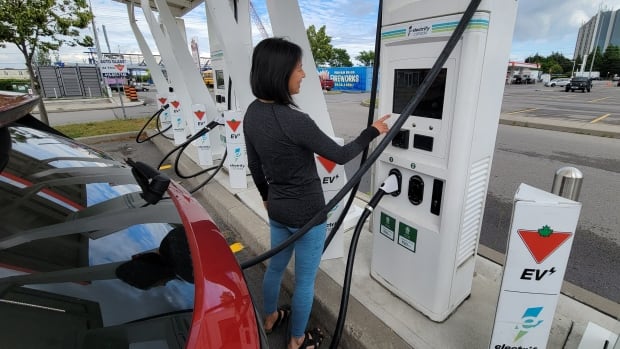
20 Mar The cars, the chargers or the customers? A look at what’s behind cooling EV sales growth
Several automakers are pulling back on plans to expand the amount of electric vehicles they produce in response to slowing sales that aren’t expected to hit previous forecasts.
At the same time, more models are coming to market and overall sales continue to grow year after year.
That’s why there’s a mix of both optimism and pessimism surrounding the EV sector and the eventual transition away from gasoline and diesel vehicles.
The state of the EV market is a focus at this year’s CERAWeek by S&P Global in Houston, one of the world’s largest energy summits. The electrification of vehicles could diminish demand for oil around the globe — and also result in big business for power producers.
“EVs, they are a terrific piece of technology,” said Chevron chief executive Mike Wirth, while on stage at the event. “They work for some customers, but not for all, and we’re seeing that in consumer behaviour and choices today.”
Automakers themselves are striking a different tone as they recognize a change in appetite from customers.

Over the last year, Nissan and Stellantis were among the companies pledging to be fully electric in Europe by 2030. At the same time, dealers have slashed prices to incentivize sales, while lowering their EV targets and even scrapping some plans to co-develop new models.
“Sales are still growing, but the rate of growth is what’s slowing down,” said Amy Stanley, an executive with Toyota North America, in an interview with CBC News.
Fuelling some of the growth this year is the abundance of new battery-powered models making their way to dealer lots, including more SUVs, which are more popular than cars in Canada and the U.S. For Toyota, sales of SUVs of all types are more than double that of cars.
Canadians are buying electric vehicles in record numbers, but there are concerns that infrastructure is not keeping up with demand. Some EV owners say they’re finding that many buildings aren’t properly equipped with charging stations.
Charging a top concern
Customers used to worry primarily about the limited range of EVs, but a top concern now is charging. That includes not only the amount of public charging infrastructure available, but also the ease of using charging stations.
The amount of time an EV charger is functioning properly is known as “uptime” and it’s becoming a point of emphasis within the industry.
“There’s certainly some examination happening in the U.S. about should there be some regulation about uptime reliability to make the charging network at least comparable to the gasoline network in terms of what customers can expect,” said Stanley.
The charging problem extends beyond the physical presence of stations — it’s also about how drivers can locate them where they do exist.
During a recent trip from Michigan to Massachusetts as part of a move, Elaine Buckberg was using multiple different apps on her phone to locate charging stations and find out if they were functioning. She felt like she was using as much concentration as her husband was while driving.
They made it through the road trip, but had to overnight in Cleveland after visiting four different charging stations only to find that none of them worked.
So Buckberg, a senior fellow of the Salata Institute for Climate and Sustainability at Harvard University, knows better than most the need for an organized directory to help locate charging stations, along with other information such as whether they’re functional and what type of charge they provide.
“We have estimated actually that only about one-third of the chargers along major highways have this kind of data available in a central location,” she said, while on stage at CERAWeek.
Changing customer base
Ford says its EV sales shot up 80 per cent last year and are expected to grow about 30 per cent this year.
Senior director Deane Millison describes how the customer base for EVs continues to change as there was an initial wave of early adopters interested in the technology and connectivity and appreciated the environmental benefits.
Now, a lot more people are thinking about EVs, said Millison, but they need more education and more understanding before they make the purchase.
“The EV demand is going up,” she said, in an interview. “If we want to be in the future in the automaking business, we need to make EVs. We need to understand this transition.”
Still, Millison says it’s all about choice and providing an assortment of vehicles to suit different customer lifestyles and preferences.
That’s why she says dealer lots will still feature gas powered vehicles alongside plug-in hybrids and EVs for for years to come.
Where you live and how much you drive each day matters when it comes to the cost-effectiveness of an electric vehicle, compared to gas. A new UBC study crunches the numbers.


